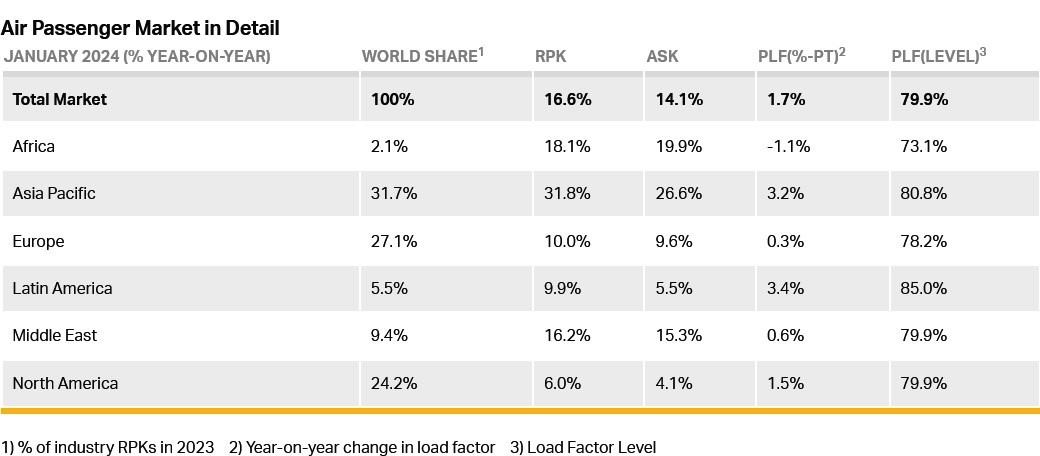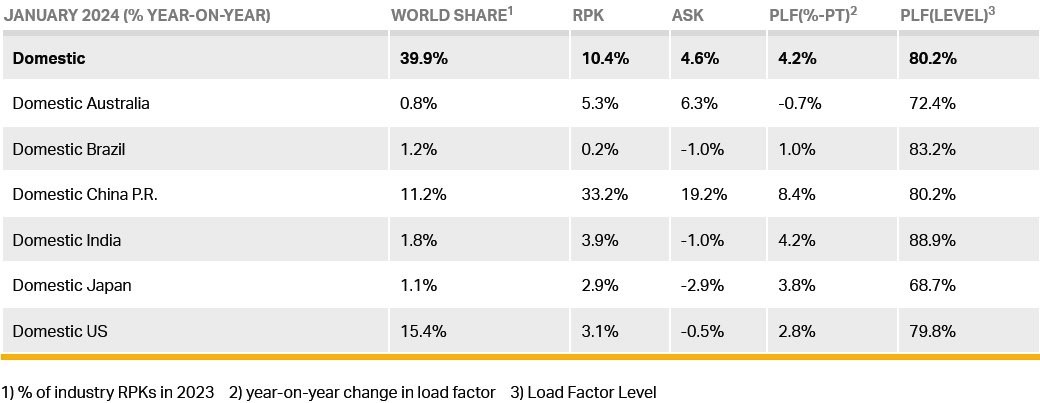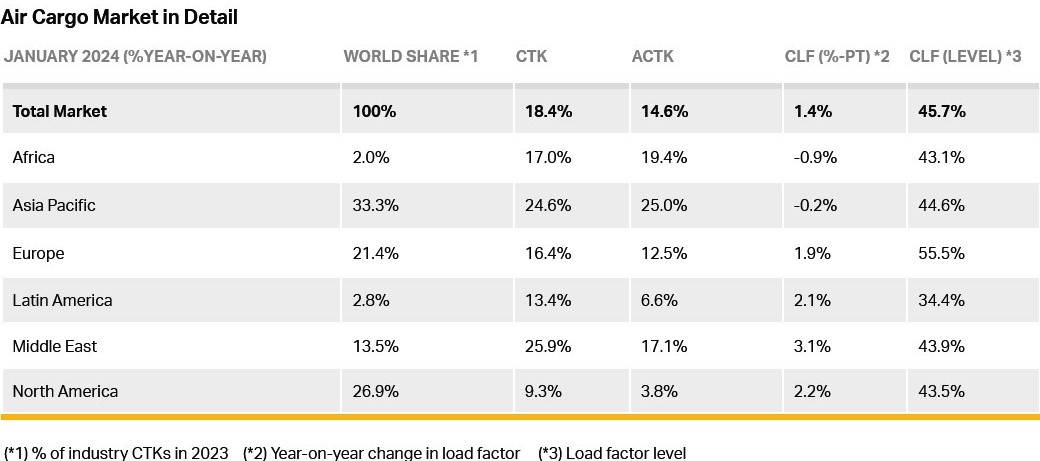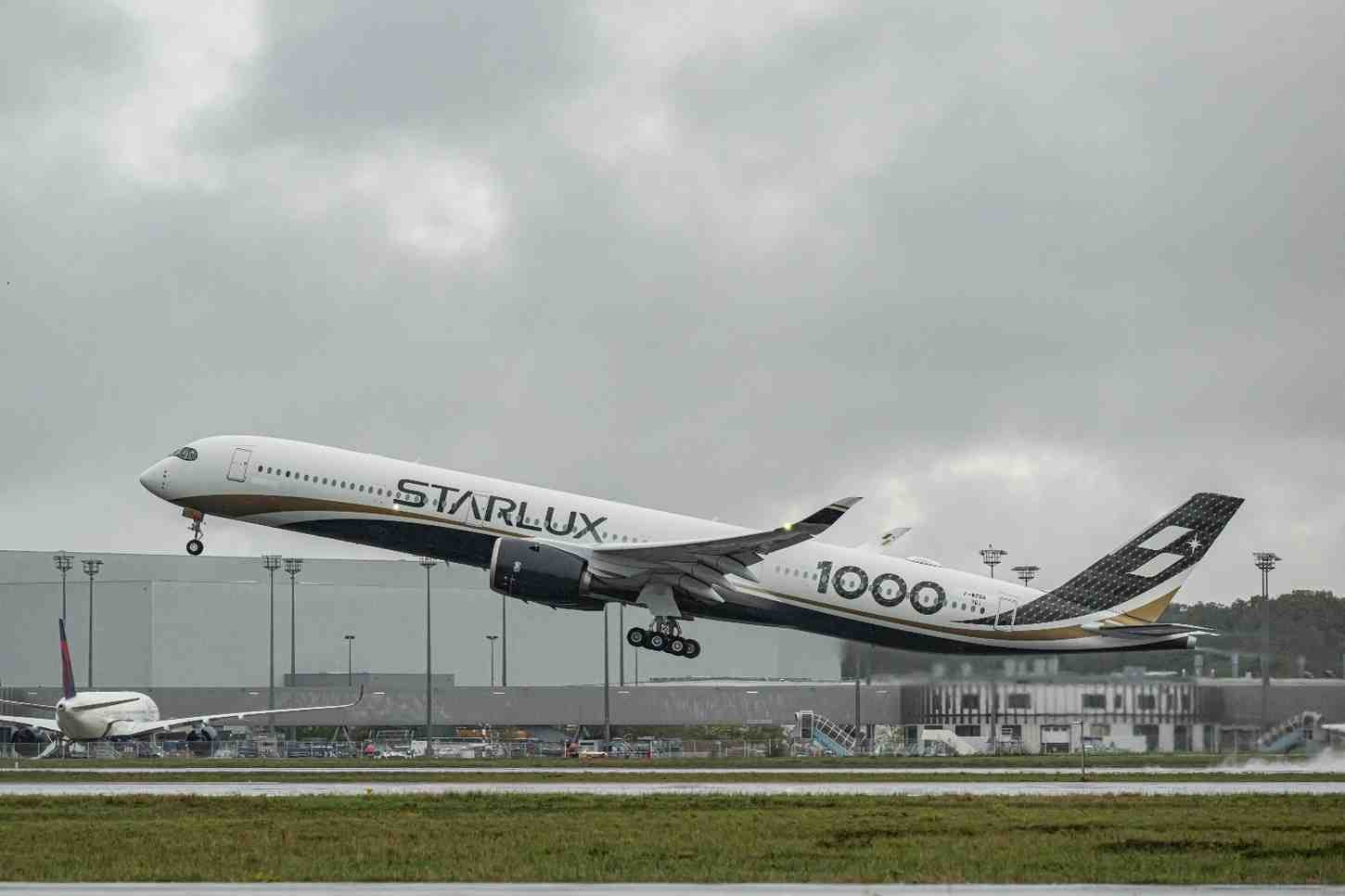IATA reports rise in passenger and cargo demand

Image courtesy IATA
Total passenger demand, measured in revenue passenger kilometres (RPKs), was up 16.6%, total capacity, measured in available seat kilometres (ASK), was up 14.1% and the load factor was 79.9% (+1.7pt)
International demand rose 20.8%, capacity was up 20.9% and the load factor remained at 79.7% (+0.0pt)
Domestic demand rose 10.4%, capacity was up 4.6% and the load factor was 80.2% (+4.2pt)
Willie Walsh (above), IATA’s Director General, said: “Twenty twenty-four is off to a strong start despite economic and geopolitical uncertainties. As governments look to build prosperity in their economies in the busiest election-year ever, it is critical that they see aviation as a catalyst for growth. Increased taxes and onerous regulation are a counterweight to prosperity. We will be looking to governments for policies that help aviation to reduce costs, improve efficiency and make progress towards net zero CO2 emissions by 2050."

International passenger markets
Asia-Pacific airlines saw an 45.4% increase in January 2024 traffic compared to January 2023, continuing the region’s rapid recovery after the lifting of pandemic restrictions. Capacity climbed 48.1% and the load factor fell by 1.5 percentage points to 82.6%. The exceptionally strong growth rate is largely attributable to China which was in the early stages of lifting COVID-19 travel restrictions in January 2023. The recovery in major international routes to/from Asia-Pacific is still lagging, but routes such as Asia-Middle East have exceeded pre-pandemic levels.
European carriers’ January 2024 traffic rose 10.8% versus January 2023. Capacity increased 10.7%, and the load factor edged up 0.1 percentage points to 77.3%. Routes between Europe and North America have rebounded particularly strongly from the pandemic and stand 6.5% higher than in January 2020.
Middle Eastern airlines posted a 16.2% rise in January 2024 traffic compared to a year ago. Capacity rose 15.7% and load factor climbed 0.4 percentage points to 79.9%.
North American carriers had a 12.3% traffic rise in January 2024 versus the 2023 period. Capacity also increased 13.7%, and load factor fell 1.0 percentage point to 79.4%.
Latin American airlines’ traffic rose 17.9% compared to the same month in 2023. January capacity climbed 13.2%, pushing the load factor up 3.4 percentage points to 86%, the highest among the regions.
African airlines’ saw a 18.5% traffic increase in January 2024 versus a year ago. January capacity was up 19.2% causing load factor to decline 0.4 percentage points to 73.3%, the lowest among the regions.
Domestic passenger markets
Domestic demand growth continues to be led by China, which saw strong demand for Lunar New Year travel. This is likely to have boosted traffic in February also. Chinese carriers have responded by increasing capacity, particularly by deploying wide-body jets.


Cargo
IATA data for January 2024 global air cargo markets, showed total demand, measured in cargo tonne-kilometres (CTKs), increased by 18.4% compared to January 2023 levels (19.8% for international operations). This significant upturn marks the highest annual growth in cargo tonne-kilometres (CTKs) since the summer season of 2021.
Capacity, measured in available cargo tonne-kilometres (ACTKs), was up 14.6% compared to January 2023 (18.2% for international operations). This was largely related to the growth in belly capacity. International belly capacity rose 25.8% year-on-year (YoY) on the strength of passenger markets.
Willie said: "Air cargo demand was up 18.4% year-on-year in January. This is a strong start to the year. In particular, the booming e-commerce sector is continuing to help air cargo demand to trend above growth in both trade and production since the last quarter of 2023. The counterweight to this good news is uncertainty over how China’s economic slowdown will unfold. This will be on the minds of air cargo executives meeting in Hong Kong next week for the IATA World Cargo Symposium with an agenda focused on digitalisation, efficiency and sustainability."
Air cargo growth outpaced trade and production. Several factors in the operating environment should be noted:
- Global cross-border trade increased by 1.0% in December compared to the previous month (-0.2% YoY).
- In January, the manufacturing output Purchasing Managers' Index (PMI) improved to 50.3, surpassing the 50 mark for the first time in eight months, indicating expansion. The new export orders PMI also saw an increase to 48.8, but remains below the critical 50 threshold, suggesting a continuing yet decelerating decline in global exports.
- Inflation in major economies continued to ease from its peak in terms of Consumer Price Index (CPI) in January, reaching 3.1% in both the US and in the EU, and 2.1% in Japan. China’s CPI, however, indicated deflation for the fourth consecutive month, raising concerns of an economic slowdown. China’s negative inflation rate of -0.8% was the lowest since the Global Financial Crisis in 2009.

January Regional Performance
Asia-Pacific airlines saw their air cargo volumes increase by 24.6% in January 2024 compared to the same month in 2023. This performance was above the previous month (+18.5%). Carriers in the region benefited from ongoing growth in international CTKs on three major trade lanes: Africa-Asia (+52.5%), Middle East-Asia (+29.5%) and Europe-Asia (+27.5%). Available capacity for the region’s airlines increased by 25.0% compared to January 2023 as more belly capacity came online from the passenger side of the business.
North American carriers had the weakest performance of all regions in January with a 9.3% increase (YoY) in cargo volumes. This was an improvement in performance compared to December (2.0%). Carriers in the region benefitted from growth on the North America-Asia trade lane (+17.1%) and North America-Europe trade lane (+3.5%). Capacity increased by 3.8% compared to January 2023.
European carriers saw their air cargo volumes increase by 16.4% in January compared to the same month in 2023. This was a stronger performance than in December (+8.6%). Carriers in the region benefitted from the strong growth in international CTKs in the within Europe market (+18.4%) and the Europe – Asia route (+27.5%). Gains made from the significant expansion in the Middle East-Europe trade lane (+46.1%) also benefited carriers in the region. Capacity increased 12.5% in January 2024 compared to the same month in 2023.
Middle Eastern carriers had the strongest performance in January 2024, with a 25.9% year-on-year increase in cargo volumes. This was a significant improvement from the previous month’s performance (+18.3%). Carriers in the region benefited from growth in the Middle East–Asia (+29.5%) and Middle East–Europe markets (+46.1%). Capacity increased 17.1% compared to January 2023.
Latin American carriers experienced a 13.4% increase in cargo volumes compared to January 2023, a notable increase compared to the previous month’s gain (+6.4%). Capacity in January was up 6.6% compared to the same month in 2023.
African airlines saw their air cargo volumes increase by 17.0% in January 2024, much improved compared to December’s performance (-1.2%). Carriers in the region benefitted from strong growth on the Africa-Asia trade lane. Capacity in January was 19.4% above January 2023 levels.












